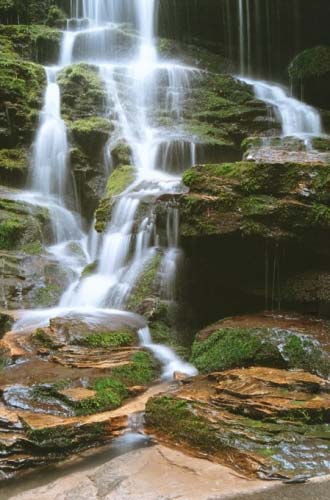SCIWAY News No. 55 – May 2008
 Previous Issues of SCIWAY News
Previous Issues of SCIWAY NewsIn This Issue
1. Penn Center: South Carolina's Hidden Treasure
Penn Center, or Penn School as it was originally called, is tucked away in the center of St Helena, a sleepy sea island in Beaufort County. It was founded in 1862 – about six months before the Emancipation Proclamation was issued, and about three years before the Civil War ended. Beneath its ancient oaks stands a vibrant community, rich in history and alive with purpose.It was one of several schools established on Saint Helena Island as part of the Port Royal Experiment. The leaders of this experiment were primarily philanthropists, abolitionists, and missionaries from Pennsylvania. They came to the Beaufort area after Union soldiers took control of the Port Royal Sound and forced the Confederates to flee, and their purpose was to help abandoned slaves prepare for freedom by teaching them how to read and survive economically. They named the school in honor of their home state, which in turn had been named for Quaker activist William Penn.
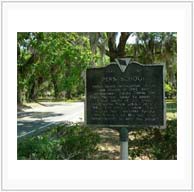 |
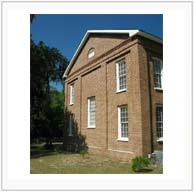 |
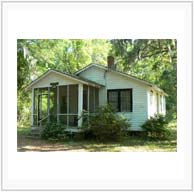 |
||||
| Historical Marker | Brick Church | Gantt Cottage |
Penn Center has played a tremendous role in the development of African-American culture – and more recently, in its preservation. By the early 1900s it had adopted Booker T. Washington's model of industrial training. This model focused on teaching black people trades like cobbling and carpentry that would help them earn a living. In Washington's own words, he wanted to make them "so skilled in hand, so strong in head, so honest in heart, that the Southern white man cannot do without [the]m."
The school continued to teach students until the middle of the twentieth century. At this time, after 86 years, the school shifted its focus and began to offer community services such as day care and health training. The change came about for a variety of reasons. One reason was that black families were moving north, causing enrollment to decline. Another important reason was that South Carolina's state and county governments finally began to take steps towards providing a more thorough education for black children. Before 1948, the public school system was only required to educate blacks through the seventh grade.
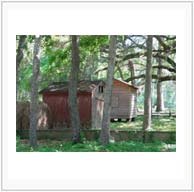 |
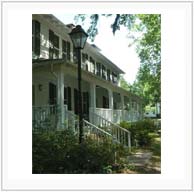 |
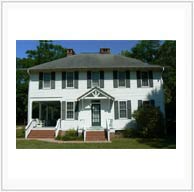 |
||||
| Small Outbuildings | Benezet House | Hampton House |
During the Civil Rights Movement, Dr. Martin Luther King, Jr. and the Southern Christian Leadership Conference often met at the Penn Center. The center served as a rare retreat where members of both races could meet peacefully without being threatened or harmed.
More recently, Penn's leaders have turned their attention to preserving the unique culture of the Sea Islands amid the onslaught of tourism and residential growth. They hold workshops to teach people how to protect heirs property and defend themselves against developers. They also organize the annual Penn Center Heritage Days Celebration, which honors Gullah traditions.
Penn Center is a 50-acre National Historic District Landmark located along both sides of Land's End Road (SC 37), near Chowan Creek. It's home to 19 historic buildings, including Darrah Hall and Brick Church. The York W. Bailey Museum is open Monday through Saturday.
Learn more by visiting our Complete Guide to St Helena Island's Penn Center.
2. May's Top Ten – Notable SC Websites
Certified SC Grown - Helping consumers easily identify, find, and buy food grown in South CarolinaCharleston's Most Unique - Events, businesses, and places that may not be mainstream but shouldn't be missed - site no longer exists
Horry County Arts and Cultural Enhancement - Information on artists and an art calendar for Horry County - site no longer exists
Plugin Hybrid Coalition of the Carolinas - Advocates cars that run primarily on electricity - site no longer exists
Statetris - Show your kids this Tetris-like game, where the blocks are SC Counties – educational and fun!
2008 SC Candidates, Election Resources - Guide to federal, state, and local websites
York County Library History Project - York County history, with searchable photograph and newspaper databases
The following websites focus on improving education standards in SC:
GoodByeMinimallyAdequate.com - Learn more about the upcoming court appeal for South Carolina schools and sign the petition for a Constitutional change - site no longer exists
RISE SC - Seeks to support and improve public education in SC at the policy-making level - site no longer exists
South Carolina Department of Education Office of Public School Choice - Public school opportunities such as magnet schools, single-gender schools, and public Montessori schools - page no longer exists
 Return to Table of Contents
Return to Table of Contents3. Building Green in the Indigo State
South Carolina is painting itself green. From your front steps to the state capitol, South Carolinians are working to build and rebuild our state to be more sustainable. Homes, churches, businesses, schools, and even whole neighborhoods are discovering the benefits of reducing waste, saving money, creating jobs, fostering stronger communities, and raising our quality of life. The changes are apparent as green buildings are sprouting up throughout SC.Our General Assembly is currently discussing tax breaks for buying energy-efficient appliances or manufactured homes, as well as providing a $1,000 tax credit for building a sustainable home. If passed, these will add to existing state and federal incentives for green buildings. In addition, the legislature is setting energy-efficiency goals for all state agencies. It already requires that all new state facilities over 10,000 square feet (except schools and prisons) achieve the LEED Silver standard. LEED (Leadership in Energy and Environmental Design) is a program of the US Green Building Council (USGBC) that certifies sustainable construction. The South Carolina Chapter of the USGBC is active in educating South Carolinians in green building practices.
SC colleges and universities are also catalysts of change. Furman built Herman N. Hipp Hall, the first LEED-certified building in South Carolina, as well as the LEED-certified James B. Duke Library. USC's West Quad is one of the largest LEED-certified residence halls in the country. Clemson has several green buildings on its campus and is requiring that all new facilities over 5,000 square feet be built to LEED Silver standard. Many of the other colleges and universities in South Carolina are engaging in similar projects, with help from the SC Sustainable Universities Initiative.
For South Carolina homeowners, several helpful resources exist. The SC Energy Office has many technical resources and is a good place to find info on various SC financial incentives for green buildings. The South Carolina Sustainability Network provides examples of how people in South Carolina are embracing sustainability.
The Sustainability Institute, based in North Charleston, serves the whole state. They've renovated the GreenHouse, which showcases sustainable building and renovation techniques. They also conduct workshops on green buildings for individual homeowners and even provide assistance to low-income households interested in lowering their utility bills. In fact, they helped South Carolinians save over $400,000 in energy bills last year alone!
4. SC Picture of the Month
Water tumbles over mossy rocks at Yellow Branch Falls.
Yellow Branch Falls in Oconee County invites hikers with its cool mist and greenery. Jason Furda was visiting the Upstate when he took this shot in June 2004. Thanks to Jason for sharing this shot with us! You can discover more of his photos at deviantART.
Contribute your shot to the SC Picture Project or see our most recent photo submissions.
 Return to Table of Contents
Return to Table of Contents
5. Upcoming SC Festivals & Events
For a complete calendar of South Carolina festivals and events, visit https://www.sciway.net/calendar.html. Here are just a few of May and early June's highlights:Aiken Bluegrass Festival - Music, food, camping, crafts - May 8-10 - site no longer available
Blue Ridge Fest - Pickens - Music, food, car cruise-in, motorcycle ride - benefit - May 9-10 - site no longer available
Greer Family Fest - Parade, children's area, petting zoo, entertainment - May 9-10 - page no longer exists
Charleston Harborfest - Tall Ship tours, maritime village, family boat building - May 16-18 - site no longer available
Blue Crab Festival - Little River - Food, music, arts & crafts, kids area - May 17-18
Palmetto Thunder Airshow - Lancaster - May 17-18 - site no longer exists
Sculpture in the South - Summerville - Featuring sculptors from across the country - May 17-18 - site no longer exists
Kid's Day Columbia - Finlay Park - Rides, food, Friday night movie – focuses on kids going green - May 23-24 - site no longer exists
Piccolo Spoleto | Spoleto Festival USA - Celebrate the arts in Charleston - May 23-Jun 8
Freedom Weekend Aloft - Simpsonville - Hot-air balloons, concerts, KidZone, Disc Dog Nationals - May 24-26 - site no longer exists
 Return to Table of Contents
Return to Table of Contents6. Parris Island: South Carolina's Buried Treasure
This month, three new classes of Marines will graduate from Parris Island. The island serves as the training ground for all new female recruits, and all new male recruits east of the Mississippi. Over 17,000 Marines graduate each year after completing a 13-week-long boot camp with quite a reputation. They will be charged with protecting one of the greatest nations in the world, and their journey begins on the same soil where power struggles to shape our country took place.First, the French...
We begin in 1562 – decades before Roanoke or Jamestown – when a group of French Huguenots led by Jean Ribault landed on our coast. By all accounts, Ribault (pronounced REE • BOW) was impressed with the land he saw. He established an outpost named Charlesfort, and left 26 or 27 men there while he sailed back to France, with the promise of returning with more people and supplies. However, his efforts were stymied once reaching France, and he wasn't able to return immediately.
Meanwhile, the men Ribault left behind were encountering difficulties of their own. After depleting food supplies and concluding Ribault was not returning, they mutinied against their commander. (We can't help but think that modern day Parris Island Marine recruits, just a stone's throw away, would sympathize!) They built their own boat and began an arduous trip back to France.
Then, the Spanish...
By this time the Spanish had established a claim to land slightly south of this area. Upon hearing of the French plans, they set out to destroy the rival's potential settlement. They burned the remains of Charlesfort, and established a fort of their own – Fort San Felipe. Here they began the new town of Santa Elena, which became the first capital of Spanish Florida. At one point, almost 200 settlers lived there, along with soldiers.
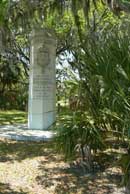 |
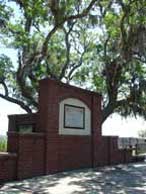 |
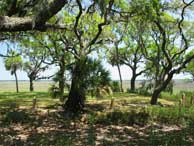 |
||||
| Charlesfort Monument | Santa Elena Monument | Moat Location |
The Power Struggle Continues...
Like the French before them, the Spanish experienced difficulties. The Native Americans (who had already been on the land for thousands of years) did not take kindly to this new settlement, and let their frustrations be known. Their attacks forced the Spanish to leave in 1576, but didn't keep them away. Led by a new commander, the Spanish returned the next year and quickly erected a new fort, Fort San Marcos. (The Indians had burned Fort San Felipe to discourage their return.)
Neither were the French ready to give up their land claim so easily, so the bloody contest for dominance continued. In the end they would all be bested by the British. The impending arrival of Sir Francis Drake forced the Spanish to abandon Santa Elena for good in 1587. When they left, they burned their fort so that it could not be used by the British or French.
For hundreds of years the exact locations of these early occupations remained a mystery. The Spaniards' extensive documentation of their expeditions made no reference to first displacing the French. This is presumedly because they didn't want to acknowledge another country's claim to the land. An excavation in the 1970's uncovered what was left of Fort San Felipe and the settlement of Santa Elena. It wasn't until the mid-1990's that two archaeologists from USC finally discovered the exact location of Charlesfort ... right under San Felipe!
Ultimately, the British claimed the first permanent settlement in South Carolina. In 1670 British colonists set out with intentions of settling on Port Royal Island, but were convinced instead to settle sixty miles north. And here, the founding of Charles Towne begins a more familiar segment of our state's history.
The sixty-acre site of these early settlements on present-day Parris Island was declared a National Historic Site in 2001. This designation gives it more visibility and considerable protection. Visitors will find pristine walking trails that wind along riverbanks through the Charlesfort and Santa Elena site.
The whirlwind of activity we've described in this article is only part of the whole story. Parris Island played host to a high-stakes game of musical chairs for decades. If only there had been a few thousand Marines around to hold down the fort ....
If you visit:
- Read more about the History of Parris Island before you go.
- There is a walking trail with signage on site details; it was designed to have no impact on the site's archaeological resources. The Parris Island Museum also houses artifacts from the site excavation.
- You may obtain a day pass at the gate by presenting your driver's license, vehicle registration, and proof of insurance. Entrance is free.
© 2008 SCIway.net, LLC. "SCIWAY News"™ is written by the team at SCIWAY – with a lot of help from people throughout South Carolina. ISSN: 1527-3903.
The SCIWAY News mailing list is not loaned or sold to anyone.
Comments and questions about this newsletter should be sent to service@sciway.net.
Back issues of SCIWAY News can be found here.
SCIway, pronounced "sky-way," is an acronym for South Carolina Information Highway.
SC Hotels
Charleston Hotels
Columbia Hotels
Greenville Hotels
SC Real Estate
Charleston Real Estate
Columbia Real Estate
Greenville Real Estate
SC Jobs
Charleston Jobs
Columbia Jobs
Greenville Jobs
SC Arts & Entertainment
SC Businesses
SC Calendar of Events
SC Churches
SC Cities, Towns
SC Colleges, Universities
SC Consumer Help Desk
SC Counties
SC Education
SC Elections
SC Facts & Firsts
SC Genealogy
SC Gifts
SC Government, Politics
SC Health, Medicine
SC History
SC Hotels
SC Jobs
SC Libraries, Museums
SC Maps
SC Movies
SC News
SC Organizations
SC Photo Gallery
SC Plantations
SC Pronunciations
SC Real Estate
SC Restaurants
SC Schools
SC Sports, Recreation
SC Tax Guide
SC Tides
SC Tourism
SC Vacation Rentals
SC Web Cams
SC Weddings






